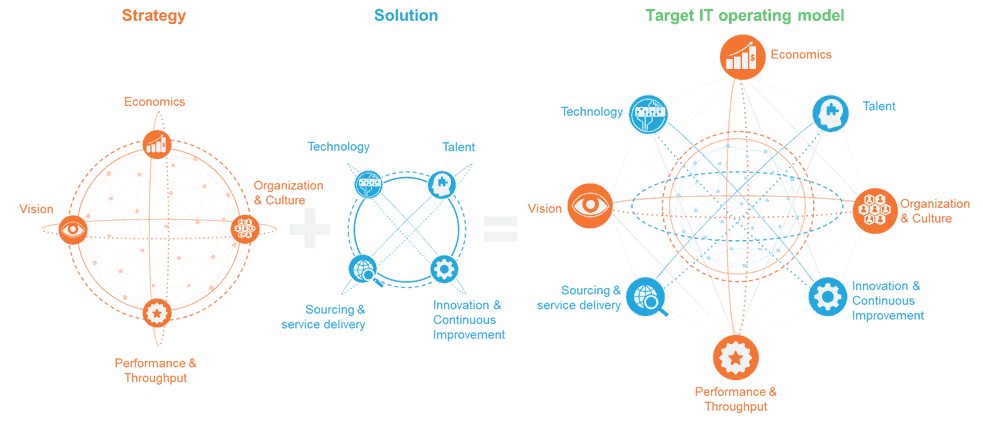Blog
It’s Time for IT Operating Model Transformation in the Medical Device Industry

As the world is working to contain the spread of COVID-19 through safety measures and vaccine development, the medical device industry also is starting to show signs of recovery from the pandemic’s impact. The decline in elective procedures hit medical device organizations’ revenue hard in the first half of 2020. But increasing demand for COVID-19 diagnostic tests is stabilizing growth and compensating for the negative impact on routine testing procedures. To support growth dynamics and ensure a stable recovery, initiatives focused on cost reduction and operating margin optimization are the top priorities for most medical device organizations. For example:
- Stryker is looking at organization-wide cost transformation for better margin expansion.
- Medtronic announced its restructuring plan to save up to US$475 million per year.
- Baxter expects to achieve an operating margin of 23-24% by 2023 through cost optimization.
How can IT operating model transformation help?
To achieve significant cost savings, medical device companies need to scale their digital transformations to reap maximum benefits, which mandates IT operating model transformation. Based on a recent survey we conducted with 200 CXOs, 80% of firms that adopt an IT operating model transformation believe they’re on their way to establishing market leadership in their respective industries, expanding to serve new market and customer segments, and achieving over one-and-a-half times more cost savings than those that haven’t initiated a similar transformation. An enterprise-wide IT operating model transformation could help medical device companies realize cost benefits and maintain a competitive edge in the market.
Yet, according to our 2020 research, nearly 78% of enterprises fail to implement their digital transformation as envisioned.
What are medical device companies doing wrong?
Most medical device companies that are transforming IT achieve success in running pilot projects but fail to realize the same impact across the breadth and depth of their enterprises, because they equate IT transformation with either technology overhaul or operating model transformation, instead of pursuing them together. Exclusively focusing on technology transformation fails because it is a siloed approach that relies too much on technology without integrating the necessary operating model changes. On the other hand, changes in only the operating model result in superficial restructuring of business units that are focused on driving tactical and incremental efficiencies, eventually leading to a plateau phase. Clearly, companies need to embrace a balanced focus on both technology and operating model transformation to scale and sustain the transformation benefits.
What’s the best approach to IT operating model transformation?
The exhibit below is a framework that outlines the strategy and solution elements that enable an IT operating model transformation. Medical device companies can leverage this framework as a blueprint to design a holistic, best-in-class approach across both strategy and solution design.
Everest Group’s Target IT Operating Model Framework

When creating the strategic roadmap, medical device enterprises should articulate a vision statement that ties together both business and IT objectives, and also carefully consider how to communicate the vision across the organization. Building an adaptable and agile organization that is resilient and collaborative is instrumental in this long journey, as 70% of enterprises believe organization structure is a barrier to scaling digital initiatives. Furthermore, effectively resourcing the IT operating model transformation and monitoring performance through cross-functional, outcome-based business metrics are keys to its success.
To complement the well-defined strategy with a strong solution framework, medical device companies should establish a strategic partner ecosystem with a fit-for-purpose portfolio of vendors. Traditional IT sourcing partnerships with a cost-centric model should evolve to a value-adding, strategic model focused on driving innovation and enabling business value. To truly scale the digital transformation and break up siloed investments, they should identify strategic partners that will equip them with the right talent, and scale the adoption of relevant next-generation technologies, so that – together – they can drive innovation with a common objective of achieving the defined vision.
As medical device organizations embark on their IT operating model transformations, we suggest a three-stage approach:
- Lay out the building blocks by painting an organization-wide vision and introducing the agile way of working by building integrated multidisciplinary teams.
- Enable the IT organization with the right solutions to become a business value orchestrator.
- Scale the impact by synchronizing effects across solutions and constantly monitoring progress through well-defined business metrics.
Please share your views on IT operating model transformation with us at [email protected] and [email protected].